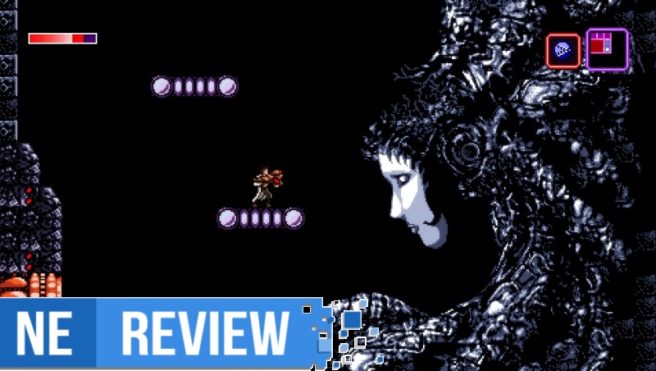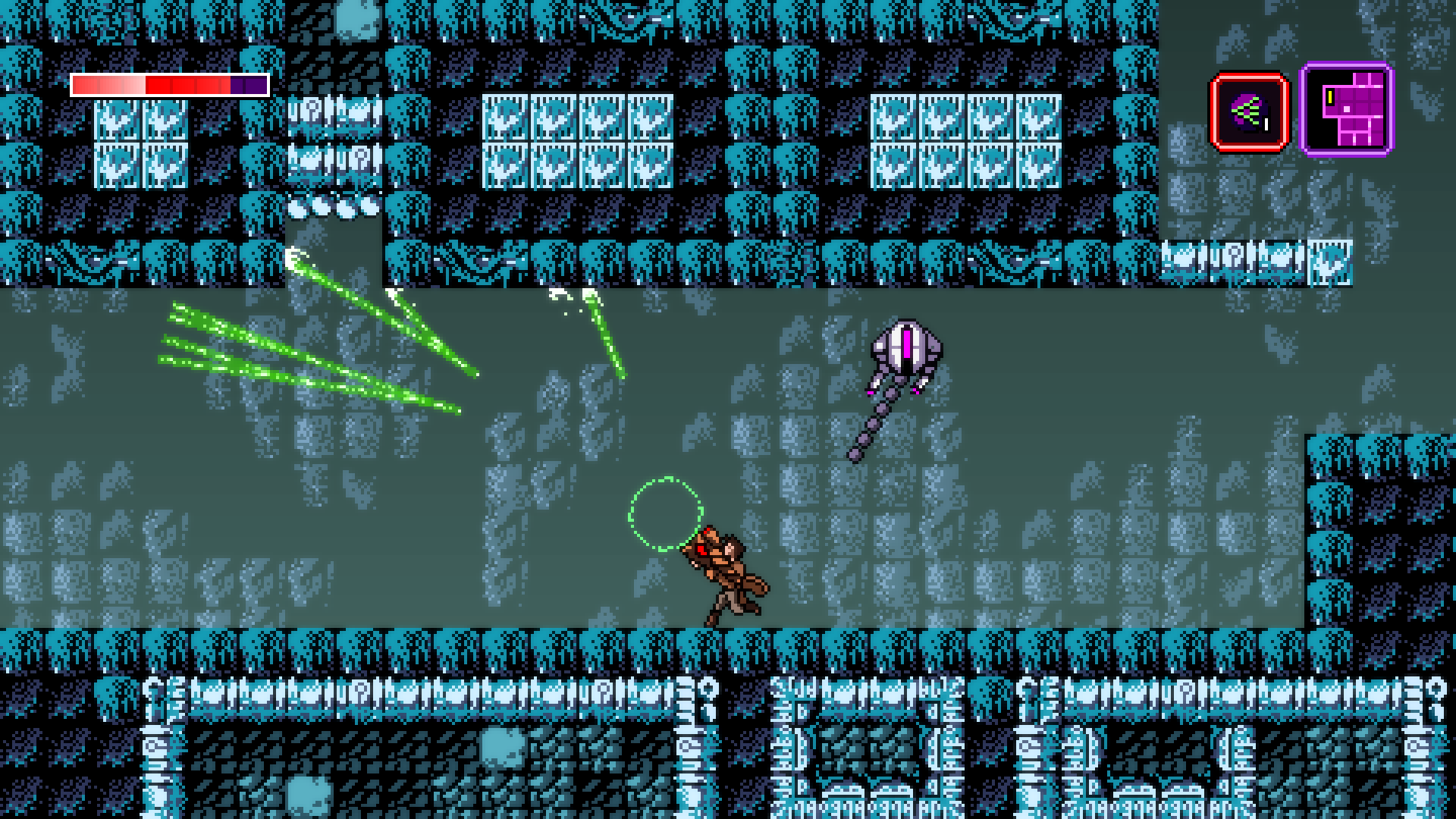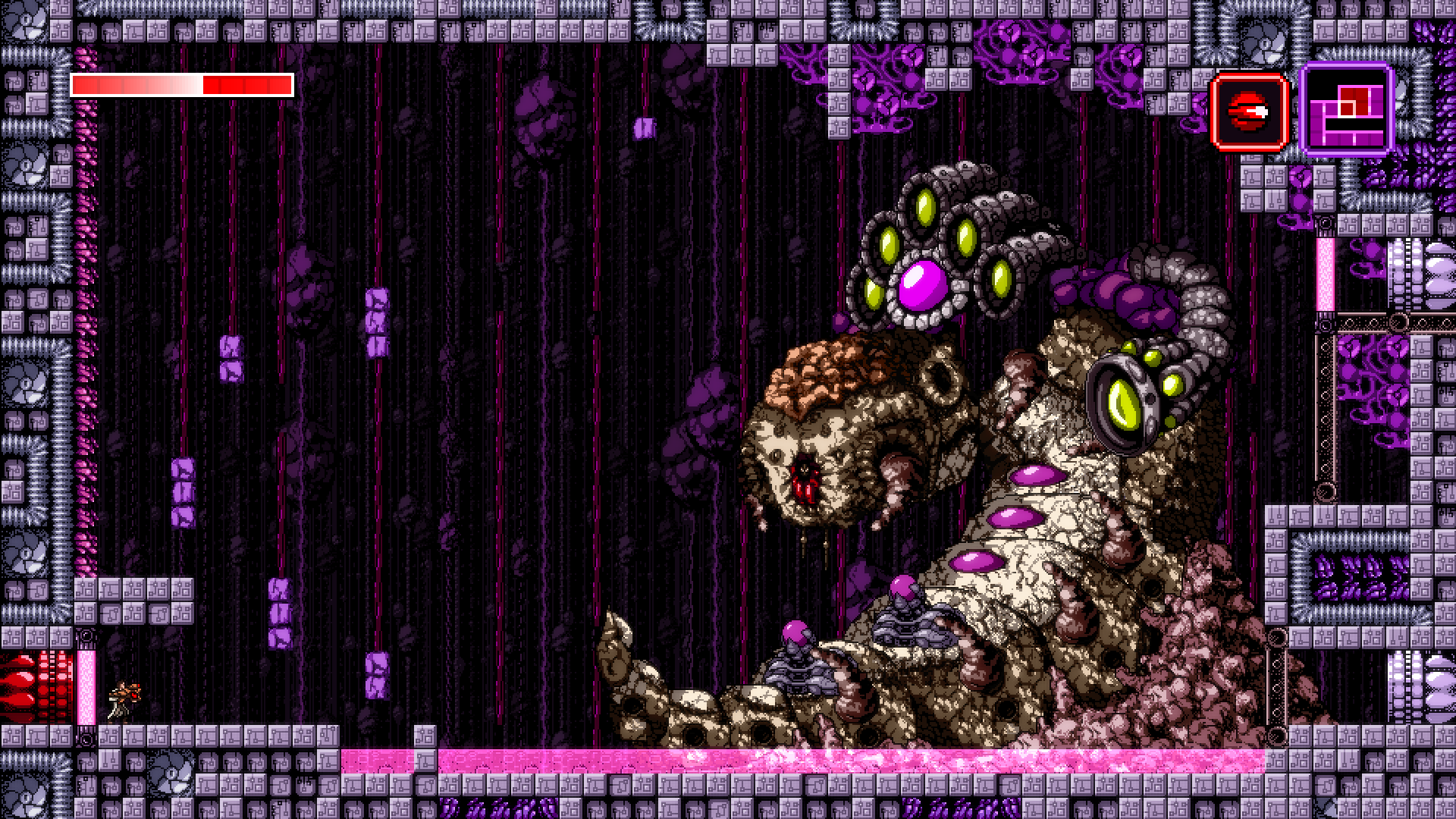[Review] Axiom Verge
System: Wii U (eShop)
Release date: September 1, 2016
Developer: Thomas Happ
Publisher Thomas Happ
When I think of the first Metroid on the NES, images of disorienting palette swapped vertical shafts with ascending and interlocking platforms connected into a webwork by horizontally scrolling rooms with enemies waiting in ambush from underground lava pools comes to mind. The imagery is distinct, but without a map it’s all very disorienting. Admittedly, I have never really played more than a few hours of Metroid. It was way before my time, and having first played Super Metroid with all of its advancements, there’s no reason for most people to go back to it beyond nostalgia and historical significance. Even with my relatively limited experience, I can tell that Axiom Verge was made out of a love and understanding of the original Metroid. However, it does more than just pay homage and instead creates mechanics and surprises with its clear admiration and understanding of Metroid as a jumping off point.
While I can’t say I know from first hand experience, Axiom Verge feels like the game that might have been conjured up in the imagination of a kid playing Metroid in 1987, squeezing every possible ounce of enjoyment through replays and exploiting its glitchy early NES code by clipping through impassable tiles and even going off the map where you might find secret worlds – which is really the game’s code freaking out. It conjures up the spirit of discovery that could only be had with the first game in the period of time its genre was new and novel with the kind of playability I expect of the genre today.
Axiom Verge originally came out in 2015, so this version is a late port. I had originally meant to play it back then after hearing a lot of praise for it, but it’s something that I never got around to. The Wii U version does have special GamePad features. On the second screen you have a quick weapon select and a full map. The GamePad integration is entirely optional and you can still access them on the more traditional pause screen along with another quick weapon select mapped to the right analogue stick, which I assume was present in the other versions. While the GamePad functionality is nice, I found all weapon select methods equally convenient. The Wii U version’s biggest asset is having the full, zoomed-out map available at all times with a quick glance at the GamePad. There’s also off-TV play which, as ever, is a great option.
Having heard a lot of praise by direct comparisons to the Metroid series a year ago, I was pretty skeptical going in. Matching or exceeding the heights of Nintendo’s classic series is a tall hurdle to jump. In the beginning I wasn’t feeling like it lived up to what I heard. It played well, but it felt a little basic with a starting area that wore its obviously Metroid-inspired sprite tileset as something that I cynically thought of as more of a grab at nostalgia than a display of affection. Within an hour, I realized I was very wrong in this judgement. The further I progressed, the more Axiom Verge came into its own with powers, abilities, secrets, and surprises unlike anything I have seen in a Metroid game, or any game of this type for that matter.
Often in this genre you can see very obviously telegraphed level design. An impenetrable block with something behind it? I’ll have to get my equivalent of a morph ball bomb and come back here. A platform that’s just a tiny bit too high to reach? I’ll have to come back with my high jump upgrade. Axiom Verge rarely resolved these assumptions in the way I thought they would. Once I realized that these common Metroid environmental cues were more often than not red herrings, it made the prospect of exploration and discovery actually feel surprising. I rarely had any idea what kind of weapon or ability would come next. Axiom Verge isn’t using Metroid as a design crutch so much as a jumping off point to subvert your expectations in ways that Metroid can’t beyond playing that first game in 1987, before the blueprint that game established became replicated countless times. There are no color-coded doors here. The game is far more intelligent than that.
The game’s different areas do distinguish themselves and establish this world’s unique identity. Like Metroid, there’s a strong ‘Aliens’ style H.R. Giger vibe to the art. A lot of its imagery feels like it draws more directly from Giger than from Metroid’s slightly neutered interpretation of the style which gives a few key moments and rooms later on a look and feeling that’s distinctly Axiom Verge. By the end of the game, it doesn’t feel like something that’s copying Metroid, aside from its presence in the series’ established ‘Metroidvania’ genre. A fully powered up Trace is far more lethal and versatile than a fully powered up Samus, and their respective full swath of abilities are hardly similar.
There’s actually a surprisingly interesting story going on here with a few twists and room for interpretation of certain events which is something I didn’t expect. I know I don’t play this kind of game for that aspect but it’s nice to see and it makes the game feel all the more well-rounded. The music is pretty great, too.

Axiom Verge is hands down one of the best Metroidvania games, and ironically one of the most original for one that is so blatantly inspired by it. Even if you’re well-versed in the genre, there’s plenty of genuine surprises to be found. I went in very skeptical and I don’t think that a game has ever turned my opinion on it around so thoroughly. To compare any game against the best of the Metroid series might normally seem unfair, but Axiom Verge can absolutely stand among them.


